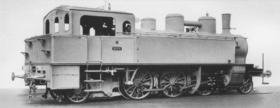Baden VI b
| Baden VI b DRG Class 75.1–3 | |
|---|---|
|
Baden VIb, No. 279 | |
| Number(s) | DRG 75 101…302 |
| Quantity | 173 |
| Manufacturer | Maffei, MBG Karlsruhe |
| Year(s) of manufacture | 1900–1923 |
| Retired | 1965 |
| Wheel arrangement | 2-6-2 |
| Axle arrangement | 1'C1' n2t |
| Track gauge | 1,435 mm (4 ft 8 1⁄2 in) |
| Length over buffers | 11,760 mm |
| Service weight | 65.3 t |
| Adhesive weight | 42.2 t |
| Axle load | 14.1 t |
| Top speed | 80 km/h |
| Indicated Power | 400 bar |
| Driving wheel diameter | 1,480 mm |
| Leading wheel diameter | 990 mm |
| Trailing wheel diameter | 990 mm |
| Cylinder bore | 435 mm |
| Piston stroke | 630 mm |
| Boiler Overpressure | 13 bar |
| Grate area | 1.92 m2 |
| Evaporative heating area | 118.62 m2 |
The Baden VI b was the first German tank locomotive with a 2-6-2 wheel arrangement. It was developed by the firm of Maffei for the Grand Duchy of Baden State Railways in order to provide faster services on the Höllentalbahn. As a result, the first six batches were given a firebox sloping to the rear. One striking feature was also the connecting pipe between the two steam domes.
After the first delivery of 15 examples from Maffei, the remaining batches, 2 to 11, were produced by the Maschinenbau-Gesellschaft Karlsruhe. The Deutsche Reichsbahn took over 164 engines, most of which survived World War II. The Deutsche Bundesbahn ended up with 117 vehicles. Their retirement from the DB began in 1957 and was completed when 75 299 was withdrawn in 1962. The Deutsche Reichsbahn in East Germany took its engines out of service between 1955 and 1965.
Within this class there were differences between the eleven individual batches in terms of overall length, weight, the height of the boiler axis above the rails and the shape of the water tanks.
None of this class is known to have been preserved.
